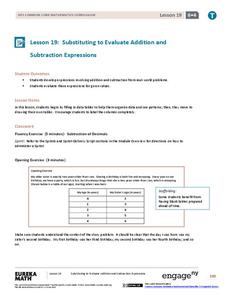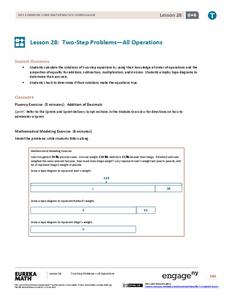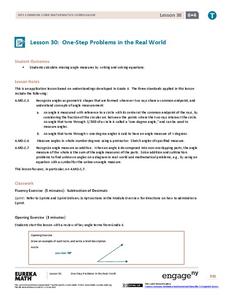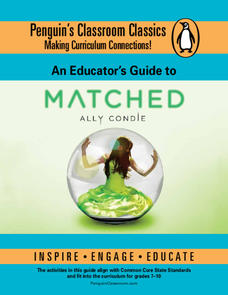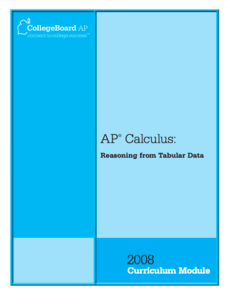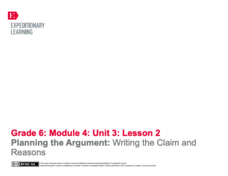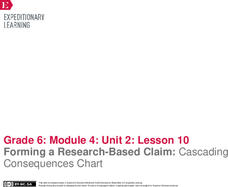EngageNY
Factoring Expressions
Factor in an informative resource when teaching about factoring. The 11th instructional activity in a 36-part module shows pupils how to factor algebraic expressions by applying the distributive property. Some of the problems involve...
EngageNY
Substituting to Evaluate Addition and Subtraction Expressions
Substitute this resource for what you used to use. Learners identify patterns in data tables and write addition and subtraction expressions to represent relationships. Substitution allows them to solve problems in context in the 20th...
EngageNY
Two-Step Problems—All Operations
Step 1: Use the resource. Step 2: Watch your class become experts in solving two-step problems. Scholars learn to solve two-step word problems in context. They use tape diagrams and algebraic techniques to break the problem into two,...
EngageNY
One-Step Problems in the Real World
Mirror, mirror on the wall, which is the fairest resource of them all? Individuals write and solve one-step equations for problems about angle measurement, including those involving mirrors. Both mathematical and real-world problems are...
EngageNY
The Mean Absolute Deviation (MAD)
Is there a way to measure variability? The ninth resource in a series of 22 introduces mean absolute deviation, a measure of variability. Pupils learn how to determine the measure based upon its name, then they use the mean absolute...
Howard Hughes Medical Institute
Stalking the Genetic Basis of a Trait
Need an a-maize-ing lesson to show your class how regulatory genes work? If you use the well-written resource, they'll be all ears! Biology scholars discover the gene responsible for the evolution of the modern-day corn plant through a...
Reed Novel Studies
Jeremy Thatcher, Dragon Hatcher: Novel Study
Don't count your eggs before they hatch—unless they are dragon eggs. Jeremy Thatcher, Dragon Hatcher follows the main character as he finds himself hatching dragon eggs. Scholars work through the resource and read how Jeremy tries to...
Reed Novel Studies
How To Train Your Dragon: Novel Study
Heroes appear in unexpected places. This is true about Hiccup, a character in How to Train Your Dragon. Scholars use a novel study to learn how a useless and weak dragon reveals his brilliance. The resource includes 10 new vocabulary...
Reed Novel Studies
The Lemonade War: Novel Study
Sibling rivalry or all-out war? The Lemonade War tells the story of a brother and sister who begin a competition selling lemonade. Scholars read to find out who will win. The resource includes vocabulary words, comprehension questions,...
Reed Novel Studies
Underground To Canada: Novel Study
Julilly dreams of freedom after being taken from her mother by a slave trader. Will she ever be free again? A resource focuses on the first chapter of Barbara Smucker's book Underground to Canada, and includes 10 vocabulary words,...
Penguin Books
An Educator's Guide to Matched by Ally Condie
Even supposed Utopian societies have their flaws. Using an educator's guide, individuals explore the society Ally Condie creates in Matched. Reflective writing prompts double as discussion questions and cover key themes in the novel, as...
Reed Novel Studies
The Yearling: Novel Study
Ever known the feeling of being stuck between a rock and a hard place? Jody, a character in The Yearling, knows this feeling all too well. Nature forces Jody to choose between his beloved pet and his family's food supply. Readers...
Reed Novel Studies
Wonder: Novel Study
Beauty is more than skin deep. Auggie, the main character in Wonder, has a facial defect, but his inner beauty shines. Taking a cue from Auggie, scholars learn how a person is more than outer appearance. To finish the resource, they...
Reed Novel Studies
The Witches: Novel Study
Are witches like lions in sheep clothing? A boy and his grandmother in The Witches thinks so. They have even discovered the secret to recognizing these evil beings that disguise themselves as sweet ladies. Scholars use the resource to...
Reed Novel Studies
The Wind In The Willows: Novel Study
True friends stick together. In the case of The Wind In The Willows, the friends just happen to be a toad, mole, rat, and badger who team up to beat the weasels. The resource covers the first chapter of their raucous adventures. Scholars...
Reed Novel Studies
The Whipping Boy: Novel Study
Sometimes people find friendships in the most unlikely places, and The Whipping Boy is no different. Few would think that Jeremy and the Prince for whom he takes whippings could ever become friends. However, after a hostage situation...
Reed Novel Studies
Redwall: Novel Study
Many dream of a place of refuge to escape from the harsh world. That is exactly what Redwall is for the creatures of the forest. Redwall is a fantasy novel that tells of the trouble that comes to a quiet and peaceful forest. Resource...
College Board
Reasoning from Tabular Data
Don't table the resource—use it now. An AP® Calculus curriculum module encourages the use of tabular data throughout the course. It provides some example topics, such as rate of change, net change, and average value of a function, where...
College Board
Extrema
No need to go to extreme lengths to find resources on extrema. The central focus of an AP® curriculum module is on critical points and extrema, and how to cover these concepts throughout the course. A set of three worksheets helps assess...
EngageNY
Planning the Argument: Writing the Claim and Reasons
Step up! Using the resource, scholars discover the six steps to writing an effective position paper. Next, they work on a graphic organizer to begin planning their argument-based essays.
EngageNY
Forming a Research-Based Claim: Cascading Consequences Chart
Is it relevant? Scholars choose a resource from their folders and search for relevant information about the harmful and beneficial consequences of DDT. They mark benefits in one color and harmful effects with another color. They then add...
EngageNY
Summarizing Notes: Planning a Graphic Novelette, Part II: The Invention of Television
Let's work together! Using the collaborative resource, scholars work in triads to begin section two of their storyboards about Philo Farnsworth, the inventor of the television. They then practice using linking words and phrases to...
EngageNY
End of Unit Assessment, Part II: Storyboard Draft, Sections 2 and 3
It's time to demonstrate knowledge. With the instructive resource, pupils complete the second part of the end of unit assessment. They develop sections two and three of their storyboards about an invention, add visual elements, and then...
EngageNY
End of Unit Assessment, Part III: Storyboard Draft, Section 4
Reflection is the best teacher. Using the resource, scholars complete the final part of their end of unit assessment, the fourth section of their storyboard about an invention. Next, they track their progress using a self-reflection form.



